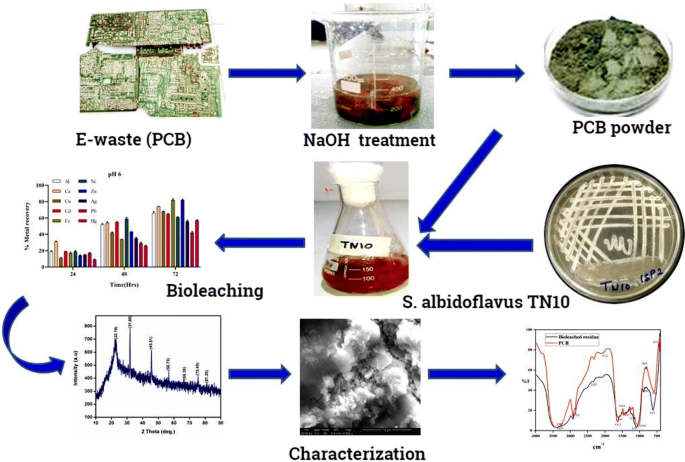当前位置:
X-MOL 学术
›
Bioresour. Bioprocess.
›
论文详情
Our official English website, www.x-mol.net, welcomes your
feedback! (Note: you will need to create a separate account there.)
Bioleaching of heavy metals from printed circuit board (PCB) by Streptomyces albidoflavus TN10 isolated from insect nest
Bioresources and Bioprocessing ( IF 4.3 ) Pub Date : 2019-11-30 , DOI: 10.1186/s40643-019-0283-3 Dhanalashmi Kaliyaraj , Menaka Rajendran , Vignesh Angamuthu , Annam Renita Antony , Manigundan Kaari , Shanmugasundaram Thangavel , Gopikrishnan Venugopal , Jerrine Joseph , Radhakrishnan Manikkam

中文翻译:

分离自昆虫巢的链霉菌Albidoflavus TN10对印刷电路板(PCB)的重金属生物浸出

Bioresources and Bioprocessing ( IF 4.3 ) Pub Date : 2019-11-30 , DOI: 10.1186/s40643-019-0283-3 Dhanalashmi Kaliyaraj , Menaka Rajendran , Vignesh Angamuthu , Annam Renita Antony , Manigundan Kaari , Shanmugasundaram Thangavel , Gopikrishnan Venugopal , Jerrine Joseph , Radhakrishnan Manikkam
Background
E-waste management is extremely difficult to exercise owing to its complexity and hazardous nature. Printed circuit boards (PCBs) are the core components of electrical and electronic equipment, which generally consist of polymers, ceramics, and heavy metals.Results
The present study has been attempted for removal of heavy metals from printed circuit board by metal-resistant actinobacterium Streptomyces albidoflavus TN10 isolated from the termite nest. This bacterium was found to recover different heavy metals (Al 66%, Ca 74%, Cu 68%, Cd 65%, Fe 42%, Ni 81%, Zn 82%, Ag 56%, Pb 46%) within 72 h under laboratory conditions. The metal content of PCB after bioleaching was analyzed by ICP-MS. The crude PCB and bioleaching residue were characterized by FT-IR, XRD, SEM for the determination of structural and functional group changes for confirmation of bioleaching.Conclusion
The findings of the present study concluded that Streptomyces albidoflavus TN10 is a promising candidate for bioleaching of heavy metals from the printed circuit board as an eco-friendly and cost-effective process.
中文翻译:

分离自昆虫巢的链霉菌Albidoflavus TN10对印刷电路板(PCB)的重金属生物浸出
背景
电子废物管理由于其复杂性和危险性而极难实施。印刷电路板(PCB)是电气和电子设备的核心组件,通常由聚合物,陶瓷和重金属组成。结果
试图通过从白蚁巢中分离的对金属有抵抗力的放线菌链霉菌Albidoflavus TN10从印刷电路板上去除重金属的尝试。发现该细菌可在72h内于72h内回收不同的重金属(Al 66%,Ca 74%,Cu 68%,Cd 65%,Fe 42%,Ni 81%,Zn 82%,Ag 56%,Pb 46%)。实验室条件。ICP-MS分析生物浸出后PCB中的金属含量。通过FT-IR,XRD,SEM对粗制PCB和生物浸出残渣进行表征,以确定结构和官能团的变化,从而确认生物浸出。结论
本研究的发现得出结论,链霉菌(Aleptoflavus TN10)是一种有前途的候选方法,可作为一种生态友好且具有成本效益的方法从印刷电路板上生物浸出重金属。











































 京公网安备 11010802027423号
京公网安备 11010802027423号